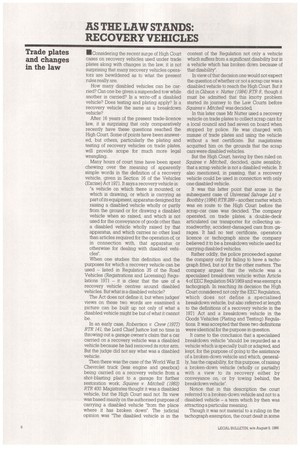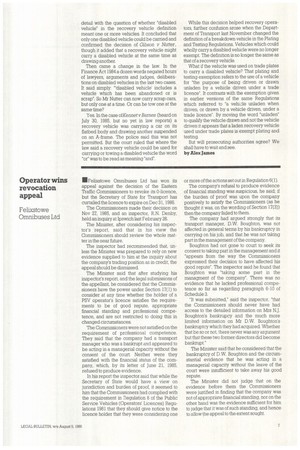Trade plates and changes in the law
Page 52

Page 53

If you've noticed an error in this article please click here to report it so we can fix it.
• Considering the recent surge of High Court cases on recovery vehicles used under trade plates along with changes in the law, it is not surprising that many recovery vehicles operators are bewildered as to what the present rules really are.
How many disabled vehicles can be carried? Can one be given a suspended tow while another is carried? Is a write-off a disabled vehicle? Does testing and plating apply? Is a recovery vehicle the same as a breakdown vehicle?
After 16 years of the present trade-licence law, it is surprising that only comparatively recently have these questions reached the High Court. Some of points have been answered, but others, particularly the plating and testing of recovery vehicles on trade plates, will provide scope for much more legal wrangling.
Many hours of court time have been spent chewing over the meaning of apparently simple words in the definition of a recovery vehicle, given in Section 16 of the Vehicles (Excise) Act 1971. It says a recovery vehicle is: "a vehicle on which there is mounted, or which is drawing, or which is carrying as part of its equipment, apparatus designed for raising a disabled vehicle wholly or partly from the ground or for drawing a disabled vehicle when so raised, and which is not used for the conveyance of goods other than a disabled vehicle wholly raised by that apparatus, and which carries no other load than articles required for the operation of, or in connection with, that apparatus or otherwise for dealing with disabled vehicles"
When one studies this definition and the purposes for which a recovery vehicle can be used listed in Regulation 35 of the Road Vehicles (Registrations and Licensing) Regulations 1971 it is clear that the use of a recovery vehicle centres around disabled vehicles. But what is a disabled vehicle?
The Act does not define it, but when judges' views on these two words are examined a picture can be built up not only of what a disabled vehicle might be but of what it cannot be.
In an early case, Robertson v. Crew (1977) RTR 141, the Lord Chief Justice lost no time in throwing out a garage owner's claim that a car carried on a recovery vehicle was a disabled vehicle because he had removed its rotor arm. But the judge did not say what was a disabled vehicle.
Then there was the case of the World War II Chevrolet truck (less engine and gearbox) being carried on a recovery vehicle from a shot-blasting plant to a garage for further restoration work, Squires v. Mitchell (1983) RTR 400. Magistrates thought it was a disabled vehicle, but the High Court said not. Its view was based mainly on the authorised purpose of carrying a disabled vehicle "from the place where it has broken down". The judicial opinion was "The disabled vehicle is in the context of the Regulation not only a vehicle which suffers from a significant disability but is a vehicle which has broken down because of that disability".
In view of that decision one would not expect the question of whether or not a scrap car was a disabled vehicle to reach the High Court. But it did in Gibson v. Nutter (1984) RTR 8, though it must be admitted that this knotty problem started its journey to the Law Courts before Squires v. Mitchell was decided.
In this later case Mr Nutter used a recovery vehicle on trade plates to collect scrap cars for a local council and had seven on board when stopped by police. He was charged with misuse of trade plates and using the vehicle without a test certificate. But magistrates acquitted him on the grounds that the scrap cars were disabled vehicles.
But the High Court, having by then ruled on Squires v. Mitchell, decided, quite sensibly, that a scrap vehicle is not a disabled vehicle. It also mentioned, in passing, that a recovery vehicle could be used in connection with only one disabled vehicle.
It was this latter point that arose in the subsequent case of Universal Salvage Ltd V. Boothby (1984) RTR 289 another matter which was en route to the High Court before the scrap-car case was decided. The company operated, on trade plates, a double-deck articulated car transporter for collecting unroadworthy, accident-damaged cars from garages. It had no test certificate, operator's licence or tachograph since the company believed it to be a breakdown vehicle used for carrying disabled vehicles.
Rather oddly, the police proceeded against the company only for failing to have a tachograph fitted, but not for the other matters. The company argued that the vehicle was a specialised breakdown vehicle within Article 4 of EEC Regulation 543/1969 and was exempt a tachograph. In reaching its decision the High Court considered not only the EEC Regulation, which does not define a specialised breakdown vehicle, but also referred at length to the definitions of a recovery vehicle in the 1971 Act and a breakdown vehicle in the Goods Vehicles (Plating and Testing) Regulations. It was accepted that these two definitions were identical for the purpose in question.
It came to the conclusion that a specialised breakdown vehicle "should be regarded as a vehicle which is specially built or adapted, and kept, for the purpose of going to the assistance of a broken-down vehicle and which, generally, has the capability, for this purpose, of raising a broken-down vehicle (wholly or partially) with a view to its recovery either by conveyance on, or by towing behind, the breakdown vehicle".
Notice that in this description the court referred to a broken-down vehicle and not to a disabled vehicle a term which by then was attracting a particular meaning.
Though it was not material to a ruling on the tachograph exemption, the court dealt in some
detail with the question of whether "disabled vehicle" in the recovery vehicle definition meant one or more vehicles. It concluded that only one disabled vehicle could be carried and confirmed the decision of Gibson v Nutter, though it added that a recovery vehicle might carry a disabled vehicle at the same time as drawing another.
Then came a change in the law. In the Finance Act 1984 a dozen words negated hours of lawyers, arguments and judges, deliberations on disabled vehicles in the last two cases. It said simply: "'disabled vehicle' includes a vehicle which has been abandoned or is scrap". So Mr Nutter can now carry scrap cars, but only one at a time. Or can he tow one at the same time?
Yes. In the case ofKennet v Barnes (heard on July 30, 1985, but no yet in law reports) a recovery vehicle was carrying a car on its flatbed body and drawing another suspended on an A-frame. The police said this was not permitted. But the court ruled that where the law said a recovery vehicle could be used for carrying or towing a disabled vehicle the word "or" was to be read as meaning "and''. While this decision helped recovery operators, further confusion arose when the Department of Transport last November changed the definition of a breakdown vehicle in the Plating and Testing Regulations. Vehicles which could wholly carry a disabled vehicle were no longer exempt. The definition is no longer the same as that of a recovery vehicle.
What if the vehicle was used on trade plates to carry a disabled vehicle? That plating and testing exemption refers to the use of a vehicle for "the purpose of being driven or drawn unladen by a vehicle driven under a trade licence". It contrasts with the exemption given in earlier versions of the same Regulations which referred to "a vehicle unladen when driven, or drawn by a vehicle driven, under a trade licence. By moving the word "unladen" to qualify the vehicle drawn and not the vehicle driven it appears that a laden recovery vehicle used under trade plates is exempt plating and testing.
But will prosecuting authorities agree? We shall have to wait and see.
by Alex James




































































































